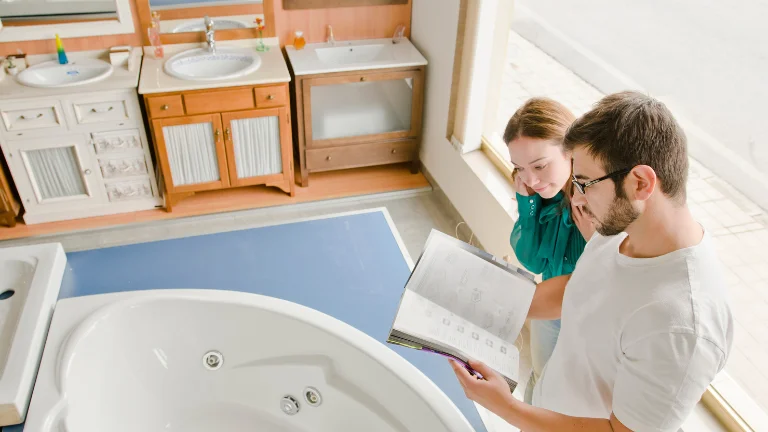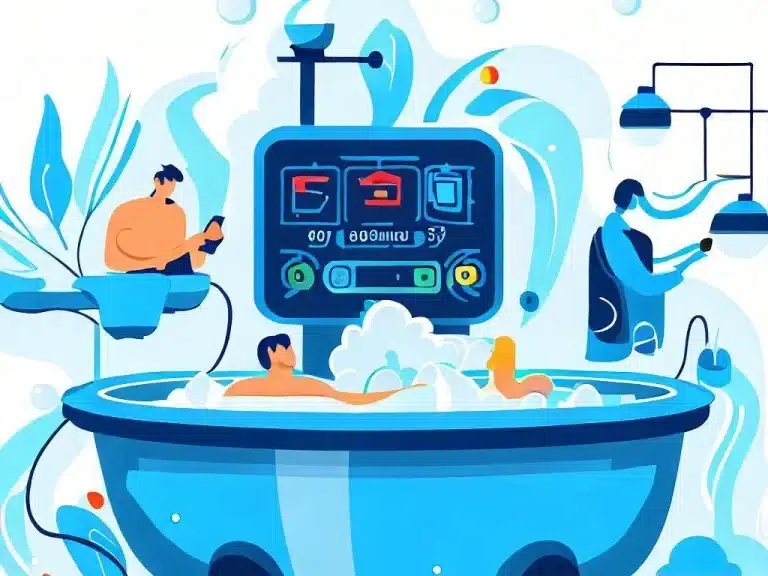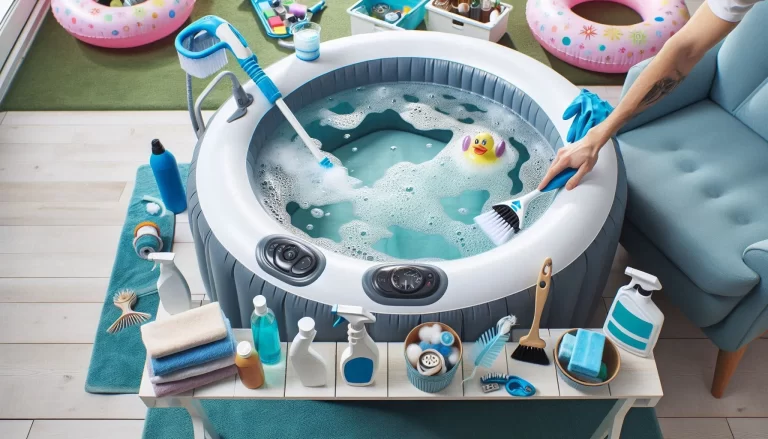5 Easy Steps: How to Shock a Hot Tub for the First Time
Want crystal-clear water and a safe soak every time? This guide walks you through exactly why, when, and how to shock a hot tub in a way that’s simple, safe, and beginner-friendly.
To shock a hot tub for the first time, test and balance your water, choose chlorine or non-chlorine shock, dissolve it in water, pour evenly around the tub, run jets for 15–30 minutes, then retest before use.
Why Shock Your Hot Tub
Shocking is like hitting the reset button on your spa water. It:
- Kills bacteria and viruses that may survive normal sanitizer levels.
- Eliminates algae that make water look green or slimy.
- Breaks down body oils, lotions, and sweat that cloud the water.
- Oxidizes metals so they don’t stain your shell or cause discoloration.
Pro Tip: Shock at night or when the tub isn’t in direct sunlight to prevent chlorine loss.
Struggling with low alkalinity? Learn how to raise alkalinity without messing up pH

When to Shock Your Hot Tub
Shock whenever your water needs a reset:
- After heavy use (lots of bathers)
- After refilling with fresh water
- If water looks cloudy or smells funky
- Once a week as part of routine maintenance
Step-by-Step: How to Shock a Hot Tub
Step 1: Understand the Process
Shocking means adding a powerful oxidizer to destroy contaminants. It restores water clarity, prevents odor, and keeps water safe.
Step 2: Prepare the Tub
- Clean the filter and remove visible debris.
- Test and balance water (pH between 7.2–7.8, alkalinity 80–120 ppm).
- Maintain proper water level and temperature before shocking.
Step 3: Choose the Right Shock
| Type | Best For | Pros | Cons |
|---|---|---|---|
| Chlorine Shock | Killing bacteria fast | Strong, affordable, widely available | Can smell, may raise chlorine level too high |
| Non-Chlorine (MPS) | Routine maintenance, sensitive skin | No chlorine smell, soak sooner | Doesn’t kill bacteria as effectively |
| Oxygen-Based | Eco-friendly option | Gentle on skin and surfaces | Often more expensive |
Watch Out: Never mix different types of shock, it can cause dangerous reactions.
Step 4: Apply the Shock
You’ll need:
- Shock treatment (chlorine or non-chlorine)
- Bucket with warm water
- Measuring scoop or cup
- Protective gloves and eyewear
- Water testing kit
Steps:
- Test the water and calculate the dosage per label instructions.
- Dissolve shock in a bucket of warm water while stirring.
- Turn off circulation and pour evenly around tub edges.
- Turn jets back on and circulate for 15–30 minutes.
- Retest water and make sure chlorine/bromine levels are safe before soaking.
Step 5: Post-Shock Maintenance
- Test and adjust water weekly.
- Clean or replace filters regularly.
- Maintain water level and circulation.
- Drain and refill every 3–4 months.
- Rinse off before soaking to keep water clean.
Strange smells in the water? Check out these tips on fixing hot tub odor problems
How to Shock a Hot Tub with Bromine
Shocking a bromine hot tub is slightly different from a chlorine spa. Here’s how to do it safely and effectively:
Why Shock a Bromine Hot Tub
- Regenerates Bromine: Non-chlorine shock converts inactive bromamines back into active bromine, keeping the sanitizer level strong.
- Removes Contaminants: Oxidizes sweat, oils, and organic debris so the bromine can focus on killing bacteria.
- Prevents Odors: Gets rid of that musty smell caused by used-up bromine compounds.
Step-by-Step Guide
- Test the Water:
- Use a bromine test strip to check levels (ideal range: 3–5 ppm).
- Check pH (7.2–7.8) and alkalinity (80–120 ppm).
- Choose the Right Shock:
- Use a non-chlorine oxidizing shock (potassium monopersulfate) for routine maintenance.
- Use chlorine shock only if you need a deep clean (after heavy use or very dirty water).
- Measure the Shock:
- Follow product directions. Most call for about 1 oz of non-chlorine shock per 250 gallons.
- Add the Shock:
- With the jets running, sprinkle the measured shock evenly across the surface.
- Let the water circulate for at least 20 minutes.
- Retest Before Use:
- Ensure bromine levels are back in the safe range (3–5 ppm) before soaking.
Pro Tips for Bromine Hot Tubs
- Shock after every heavy soak or at least once a week.
- Keep the cover off for 20–30 minutes after shocking to allow gases to escape.
- If bromine levels are consistently low, check if your bromine floater or feeder needs more tablets.
How to Shock a Hot Tub with Chlorine
If your hot tub uses chlorine as the primary sanitizer, shocking is key to keeping the water crystal clear and germ-free. Here’s exactly how to do it:
Why Shock a Chlorine Hot Tub
- Destroys Contaminants: Breaks down sweat, lotions, and organic matter that cloud water.
- Restores Free Chlorine: Replenishes sanitizer levels so bacteria don’t get a chance to grow.
- Prevents Algae: Keeps green water and slime at bay.
Step-by-Step Guide
- Test Your Water:
- Check free chlorine (should be 1–3 ppm before shocking).
- Test pH (target 7.2–7.8) and adjust if needed for best results.
- Pick the Right Shock:
- Use a chlorine-based shock (calcium hypochlorite or dichlor) for deep cleaning.
- For regular maintenance, you can alternate with non-chlorine shock to reduce chemical smell.
- Measure the Shock Dose:
- Follow the instructions on the product label. Typically, 1–2 oz per 500 gallons is recommended for routine shocking.
- Dissolve (If Required):
- Some chlorine shocks need pre-dissolving in a bucket of warm water. Stir until fully dissolved.
- Add the Shock:
- Pour evenly around the hot tub with jets running to help distribute.
- Leave the Cover Off:
- Allow gases to escape for at least 30 minutes.
- Retest Before Using:
- Make sure chlorine levels drop back to 3–5 ppm before getting in (usually 8–24 hours depending on dose).
Pro Tips for Chlorine Hot Tubs
- Shock once a week or after heavy use.
- If chlorine smell is strong, it means there are combined chlorines, shock again to burn them off.
- Keep extra test strips handy so you always know when the water is ready to use.
Chlorine vs. Non-Chlorine Shock: Comparison
| Feature | Chlorine Shock | Non-Chlorine Shock |
|---|---|---|
| What It Does | Kills bacteria, algae, and oxidizes organic contaminants | Oxidizes contaminants but does not kill bacteria |
| When to Use | After heavy use, refilling, or when sanitizer levels are low | For routine weekly maintenance or to clear cloudy water without raising chlorine |
| Effect on Chlorine Levels | Raises chlorine level temporarily | Does not raise chlorine level |
| Wait Time Before Use | Usually 6–24 hours (depends on dosage) | Can often re-enter in 15–30 minutes |
| Best For | Deep cleaning and sanitizing | Maintenance between chlorine shocks |
| Cost | Typically less expensive | Usually slightly more expensive |
| Compatibility | Works with chlorine and bromine systems | Works with all sanitizer systems |
Pro Tip: Use chlorine shock once a week or after heavy use, and non-chlorine shock for mid-week touch-ups to keep water consistently clean.
How to Shock a Green Hot Tub (Clear Algae Fast)
If your hot tub water has turned green, algae is the likely culprit. Here’s how to get it back to crystal clear:
Step-by-Step Green Water Recovery
- Turn Off the Jets:
- Stop circulation so the algae can settle. This makes vacuuming or skimming easier.
- Remove Debris:
- Skim out leaves, dirt, or anything floating on the surface.
- Test and Adjust Water Chemistry:
- Check pH and alkalinity first. Balance to pH 7.2–7.4 (slightly lower pH makes shock more effective).
- Double or Triple Shock:
- Use chlorine shock at 2–3 times the normal dose to kill algae fast.
- Pre-dissolve if required and pour evenly around the tub.
- Run the Circulation System:
- Turn jets on and let the water circulate for several hours to mix chemicals and filter out dead algae.
- Clean or Replace the Filter:
- A dirty filter will just keep circulating algae spores. Clean it thoroughly or swap in a new one.
- Retest and Balance:
- After several hours, retest sanitizer levels. Adjust pH, alkalinity, and chlorine as needed.
- Repeat if Needed:
- If water is still slightly green or cloudy after 24 hours, shock again at normal dose.
Check our full guide 5 Reasons Why Your Hot Tub Water is Green
Pro Tips for Preventing Green Water
- Keep sanitizer levels in the safe range at all times.
- Clean the filter regularly and drain/refill every 3–4 months.
- Shower before soaking to reduce organic debris entering the tub.
- Keep the cover on when not in use to block sunlight (algae loves sunlight).
How to Super Shock a Hot Tub (Deep Clean Treatment)
Sometimes your hot tub needs more than a regular weekly shock, especially if the water is very dirty, has strong odors, or after a long period of no use. Here’s how to perform a super shock treatment safely.
When to Super Shock
- After a major contamination (body fluids, lots of dirt, or heavy bather load)
- When water has strong chlorine or musty smell (indicates combined chlorines or bromamines)
- If the water is green, cloudy, or foamy and normal shocking didn’t work
- After draining and refilling, before the first soak
Step-by-Step Super Shock Guide
- Test and Balance Water First:
- Adjust pH to 7.2–7.4 and alkalinity to 80–120 ppm.
- Use a High Dose of Shock:
- Add 2–3 times the normal amount of chlorine-based shock.
- Example: If you normally use 1 oz per 500 gallons, use 2–3 oz for super shock.
- Pre-Dissolve (If Needed):
- Mix in a bucket of warm water before adding to the tub.
- Distribute Evenly:
- Pour solution around the edges with jets off, then turn them on to circulate.
- Leave Cover Off:
- Keep the hot tub uncovered for at least 30–60 minutes to allow gases to escape.
- Run Circulation System:
- Let it circulate for several hours (ideally overnight) to fully sanitize.
- Retest Before Using:
- Chlorine should drop back to 3–5 ppm before soaking. This may take 24 hours or more.
Pro Tips for Super Shock Success
- Clean or replace filters immediately after super shocking.
- If using bromine, you can super shock with non-chlorine shock to regenerate bromine levels.
- Always wear gloves and eye protection, super shock uses a much stronger chemical dose.
- Consider draining and refilling if the water is very old (3+ months) even after super shocking.
Best Shock Products for Beginners
| Product | Pros | Cons |
| Leisure Time Spa 56 Chlorinating Granules | Strong sanitizer, easy to find, budget-friendly | Has strong chlorine smell |
| SpaGuard Enhanced Shock | Multi-purpose (sanitizes + clarifies), reliable brand | Pricier than basic chlorine shock |
| Leisure Time Renew Non-Chlorine Shock | Odor-free, safe for quick soaking | Doesn’t kill bacteria as well, best for maintenance not clean-up |
Pro Tip: Keep one chlorine-based shock and one non-chlorine option on hand. Use chlorine for deep cleans, non-chlorine for weekly maintenance.
Common Mistakes to Avoid
- Skipping water testing before shocking.
- Using too much shock, which can irritate skin.
- Forgetting to clean filters.
- Using household cleaners in the tub.
- Eating or drinking too much alcohol in the hot tub.
Troubleshooting Cloudy Water
For more information about chlorine shock for hot tubs, click here.
If water is still cloudy after shocking:
- Check and clean the filter.
- Balance pH and alkalinity.
- Make sure jets circulated long enough.
- Consider a clarifier if particles remain suspended.
Check our guide about hot tub maintenance.
Why Your Water Is Still Cloudy After Shocking
Even after a proper shock treatment, your water might stay cloudy. Here are common reasons and quick fixes:
| Problem | Possible Cause | Quick Fix |
|---|---|---|
| High Calcium Hardness | Too many dissolved minerals in the water | Test calcium hardness and partially drain/refill to lower levels |
| Dirty or Clogged Filter | Filter can’t remove particles effectively | Clean or replace the filter, then run circulation for several hours |
| Unbalanced pH or Alkalinity | Improper water chemistry prevents sanitizer from working properly | Retest and adjust pH (7.2–7.8) and alkalinity (80–120 ppm) |
| Not Enough Shock | Under-dosing leaves organic matter behind | Recalculate dosage based on gallons and shock again |
| Biofilm Buildup | Slimy layer inside plumbing harbors bacteria | Use a spa line flush product before the next drain/refill |
| Poor Circulation | Water not circulating long enough after shock | Run jets and pump for 4–6 hours to help filter out contaminants |
Pro Tip: Cloudy water can take several hours to clear completely even after a perfect shock. Leave the pump running and retest the water later the same day.
Common Mistakes to Avoid
- Neglecting Water Testing: Failing to test and balance water chemistry regularly can lead to cloudy or unsanitary water.
- Overusing Shock Treatment: Too much shock treatment can damage your hot tub’s components and irritate your skin and eyes.
- Ignoring Filter Maintenance: Refrain from removing filter cleaning or replacement can reduce water circulation and filtration efficiency.
- Using Household Cleaners: Non-approved cleaning products can damage hot tub surfaces and water quality.
- Not Showering Before Use: Not showering before entering the hot tub can introduce oils, lotions, and dirt into the water, making it harder to maintain.
- Drinking Alcohol in Excess: Excessive alcohol consumption can impair decisions and raise the risk of accidents.
- Eating Inside the Hot Tub: Food residues can contaminate the water and clog the filter.
- Ignoring Safety Measures: Failure to adhere to safety guidelines, such as not exceeding maximum occupancy or temperature limits, can lead to accidents.
- Improperly Sealing the Cover: Leaving gaps or not securing the cover properly can result in heat loss and increased energy consumption.
- Skipping Regular Draining and Refilling: Neglecting to replace the water periodically can result in mineral buildup and poor water quality.
- Using Abrasive Cleaning Tools: Scrubbing with abrasive materials can damage the hot tub’s surface and create hiding places for bacteria.
- Not Educating Users: Not informing all hot tub users about proper usage and etiquette can lead to misuse and water quality issues.
If leaves and dirt keep ending up in your spa, here’s a quick guide on keeping debris out of your hot tub
NOTE
Remember to carefully read and follow the instructions provided on the product label. For more information on hot tub care and maintenance, refer to the Centers for Disease Control and Prevention (CDC) resources.
🔗 Explore More Hot Tub Resources
Discover everything you need to know about hot tubs, from installation tips to health benefits.











5 Comments